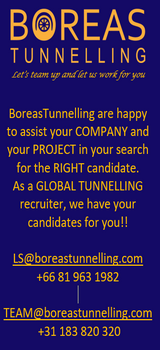Auckland's Central Interceptor TBM to start boring under the Manukau Harbour
Watercare of Auckland is building the Central Interceptor "Super Sewege", a 13km long 4,5m diameter tunnel to remove the sewage from Auckland's streets and beaches.
Now the project has reached a new phase with the tunnelling to start under the Manukau Harbour in first such an undertaking under a major harbour in New Zealand.
Central Interceptor Tunnel Boring Machine begins historic tunnelling under Manukau Harbour
Hiwa-i-te-Rangi, our Central Interceptor Tunnel Boring Machine (TBM) is about to create history as she begins tunnelling 1500m across the Manukau Harbour, in the most challenging section of her 14.7km journey from Māngere to Grey Lynn.
Hiwa-i-te-Rangi is just metres away from the water’s edge and should reach the harbour by 4am tomorrow, Wednesday. This is the first-time tunnelling has taken place under a major New Zealand harbour. Previously, we tunnelled under a small section of Hobson Bay to create the Hobson wastewater tunnel. And in 2009, a TBM also dug a 600m undersea tunnel for the Rosedale Wastewater Treatment Plant outfall pipe. Hiwa-i-te-Rangi is currently sitting underneath Kiwi Esplanade, Māngere Bridge, just centimetres from the harbour. It will take around four months for her to travel across to Hillsborough at depths of 15-20m below the seabed.
Auckland Mayor, Phil Goff went underground to see the tunnel for himself in July and has been following progress: “It was fantastic to be able to see the tunnel boring machine in action and to know that the end product of this work is that we will be able to cut by over 80 per cent wastewater overflows into the Waitemata Harbour from the western isthmus.
“Stormwater infiltrating into wastewater has caused overflows into our harbours and waterways for a century and finally we are taking the critical action needed to help ensure we have clean beaches and harbours.”
Central Interceptor executive programme director, Shayne Cunis says everyone is focussed on the big task ahead: “Hiwia-i-te-Rangi has travelled more than 2.5km since she began her 14.7km journey in August last year from Māngere Treatment Plant. Our contractors, Ghella Abergeldie Joint Venture have vast international experience and they’ll be working 24/7 to ensure the TBM keeps tunnelling non-stop to the other side.
“In recent days, Hiwa-i-te-Rangi has been checked thoroughly, including the cutterhead. More than 30 ‘cutting discs’ have been swapped for ‘rippers’ for maximum efficiency as she powers her way through East Coast Bays Formation rock all the way to Grey Lynn.”
A maximum of 29 tunnellers are allowed inside the tunnel at any time. Cunis says enormous efforts have gone into ensuring tunnellers are kept safe: “There are two refuge chambers (which provide shelter during emergencies) and workers carry back-up breathing apparatus. Potential hazards include fire and water ingress. More than 100 bore samples were taken before construction began, to ensure the geology was well understood along the route.
Undersea tunnels are rare—the Channel Tunnel between UK and France is the probably the most famous example. Head of health safety and well-being, Bronwyn Struthers says safety has always been an absolute priority for the $1.2b Central Interceptor project: “We are committed to keeping all our workers safe. We built a dedicated training centre and everyone undergoes a two-day induction programme, as well as regular underground training. We even imported a section of a real TBM so tunnellers could practise replacing the cutterhead tools and climbing into a decompression chamber. We are also the only project in New Zealand to introduce a card identification system, which indicates where workers are located, should they become incapacitated.
The 4.5m diameter tunnel is made up of rings, each one is formed by six concrete segments that are fixed together underground. Hiwa-i-te-Rangi was named by school students along the tunnel route. The custom-built Earth Pressure Balance machine came from Germany and features a 5.4m cutterhead with titanium cutters. Soil and rock pass through the machine via a series of conveyor belts and is loaded into “muck skips” for removal by electric locomotives and a crane. Initially tunnellers walked to reach the TBM during shift changes, now the tunnel is so long, they ride in small locomotives. Lead engineer Bojan Jovanovic says the electric locomotives have real advantages “They are quieter, more sustainable, and best of all, they emit no diesel fumes.”
Each day, Hiwa-i-te-Rangi travels up to 16m each day and lays eight to 10 tunnel rings. The tunnel has a coloured plastic liner to protect against the corrosive effects of wastewater to give it a design life of 100 years. The colour changes indicate different steel reinforcement in the segments which are governed by the changing geology. The TBM was launched in the most challenging soil conditions: Kawa sands and the liner was blue. As tunnelling has progressed, grey and pink tones have emerged. Half-way across the Manukau Harbour, the liner will change to yellow, as the ground changes to East Coast Bays Formation sandstone rock.
The harbour crossing will be closely followed by the Central Interceptor’s ‘rival’ tunnelling team, who are building the first of two branch sewers. The team is operating a micro-Tunnel Boring Machine called ‘Domenica’. So far, she has made two breakthroughs as she travels from May Rd, Mount Roskill en route to Miranda Reserve, Avondale.
https://www.watercare.co.nz/About-us/News-media/Central-Interceptor-Tunnel-Boring-Machine-begins-h
Auckland Watercare Central Interceptor Harbour Crossing Tunnel Map (Watercare media release)
cover tunnel photo by: Matt Brown from London, England / CC BY
Copyright 2019-2024 TunnelContact.com








https://www.1news.co.nz/2022/09/15/first-tunnelling-to-begin-under-major-new-zealand-harbour/
First tunnelling to begin under major New Zealand harbour
www.1news.co.nzTunnellers are boring under Auckland's Manukau Harbour as part of the Central Interceptor project, an upgrade to the city's wastewater system.